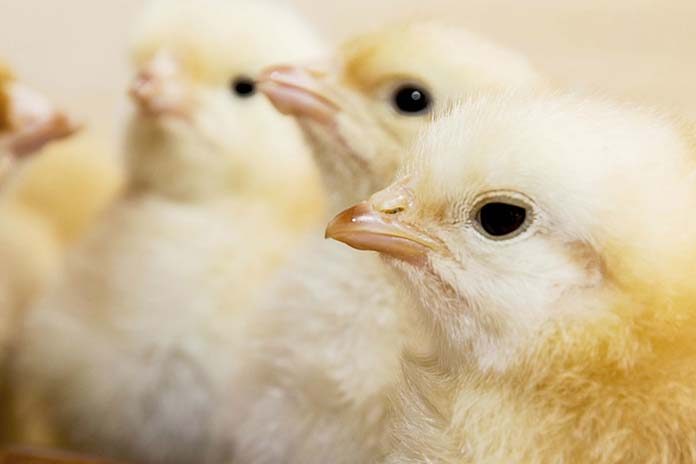
Elevated corticosterone in ovo can have significant lasting impacts in avian species, including poultry. Stress in broiler breeder hens can lead to elevated corticosterone in the egg, exposing the developing embryo, leading to lifelong changes. This study aimed to mimic these effects by injecting broiler eggs with corticosterone or phosphate buffered solution at embryonic day eleven, into the chorioallontoic membrane. Differences were seen in growth during the final week, with corticosterone injected birds lighter. Behavioural changes were also observed in males, using tonic immobility testing, at day 14 (P < 0.05). These changes show that exposure to elevated corticosterone at embryonic day eleven has long-term impacts on chick growth and behaviour. Further research into this area and larger trials using this injection time point are needed to be conducted to further look at these changes.
Hens exposed to an environment of increased stress can have significantly elevated circulating corticosterone levels, increasing deposits of corticosterone within the egg. Embryos within the egg are exposed to this increase in corticosterone during development, and changes to the hypothalamic-pituitary-adrenal (HPA) axis can occur.
These changes can then go onto to impact the lifelong health of the embryo with reductions in growth immune response and changes in behaviour. In other species these changes occur through a process known as developmental programming and have been proven to have significant impacts later in life. This area is still being researched and understood, and this study aimed to further understand the lifelong impacts of in ovo exposure of elevated corticosterone in chicken embryos on lifelong growth and behaviour.
a) In ovo injections
A total of 144 eggs were collected from Baiada hatchery and incubated at the Roseworthy Campus, University of Adelaide. At embryonic day eleven, 96 eggs were injected with corticosterone (1μg in 100μl phosphate buffer solution) and the remaining eggs injected with the phosphate buffered solution (PBS) only. This dose rate was chosen as it was used in previous studies, as a high dose and has therefore been demonstrated to have measurable effects throughout the lifetime of the embryo. Also, corticosterone concentrations can vary substantially between eggs and hens and, as we had no control over the hens, we wanted to ensure the dose was high enough that the corticosterone group was significantly elevated compared to the control group. Solutions were injected into the chorioallantoic (CAM) membrane sing a 1mL insulin syringe and needle after a hole was made using a 23G needle. After the injection, the hole was sealed and the egg continued through incubation as normal.
b) Blood sampling
At 35 days of age, 32 birds were blood sampled via the jugular vein. Samples were centrifuged at 3500rom for five minutes, and the plasma collected and stored at -20°C. Sample were then sent to the School of Animal Biology, University of Western Australia where it underwent radioimmunoassay testing for corticosterone using a Corticosterone 125I RIA KIT (MP Biomedical, Orangeburg, NY).
c) Animal husbandry
After hatch, chicks were weighed, feather sexed and placed into treatment pens. Chicks from each treatment (corticosterone or PBS) and sex were placed together. Chicks were monitored daily for signs of ill health and unwell birds were culled. Throughout the trial chicks had ad libitum access to water and a commercial broiler diet and were individually weighed weekly for the duration of the trial (6 weeks).
d) Tonic immobility test
All birds undertook a tonic immobility test (TI) at 14 days of age. Birds were placed onto their back and restrained for 20 seconds, where after the restraint was removed and birds allowed to flip over onto their front. The time taken for birds to do this was recorded in seconds, with a maximum score of 60 seconds possible. Results from the test were then placed into categories of slow or fast responses, with fast being 0-29 seconds and slow being 30-60 seconds.
e) Statistical tests
Statistical tests were performed using the IBM SPSS program, version 21 with a P value < 0.05 considered significant. A Fischer’s exact test was used for the tonic immobility data.
Results
a) Average daily gain
During the six week grow out trial, birds that were injected with corticosterone and PBS in ovo, maintained similar average daily gain (ADG) throughout the first five weeks of the trial. However, a significant split is seen between the two groups from week five to week six, where by week six corticosterone injected birds had a significantly lower ADG (96.446±3.815) compared to PBS treated birds (121.822±6.474).
b) Plasma corticosterone
At day 35, plasma corticosterone (ng/mL) was significantly (P < 0.05) different between corticosterone and PBS injected birds. Corticosterone treated birds had significantly lower levels (480.66 ± 45.12) compared to PBS birds (648 ± 53.93).
c) Tonic immobility
At day 14, no significant difference was seen between response times in the tonic immobility test between in ovo injection treatments (P > 0.05). There was however a significant difference in speed between males injected with corticosterone and PBS (P < 0.05). A higher number of corticosterone injected males were slow to flip over (n=23) than were fast (n=11).
Discussion
a) Average daily gain
Average daily gain (ADG) was unaffected for the majority if the trial, but was significantly impacted by treatment during the final week of growth. Corticosterone treated birds grew less during this final week than PBS birds, with other trials reporting similar reductions in growth after exposure to increased corticosterone in ovo. Corticosterone can have many lasting impacts on the body, and if elevated can mean decreased IGF-1, which may lead to a reduction in growth. Unfortunately, IGF-1 levels were not recorded in this trial so it is unclear if there were differences between treatments. Also, broilers grow rapidly, with a 400% increase in broiler growth in the last 50 years and therefore develop much faster than other species. In humans and other species exposed to altered uterine environments, metabolic diseases including diabetes can arise, but are often not seen until later in life. This may explain why these changes in the broilers were not observed until the final week of growth. However, metabolic measures were not recorded in this trial so future work would need to include these measures on birds that have been exposed to elevated corticosterone in ovo to better understand the impacts on metabolism and growth and why they are occurring.
b) Plasma corticosterone
In this study plasma corticosterone was significantly different between in ovo treatments at day 35. Surprisingly, the birds injected with corticosterone had lower levels than the PBS injected birds which may mean that there is a down-regulation of corticosterone occurring later in the life of the bird. Impacts on growth were still seen from day 35, with corticosterone still supressing growth as in other trials with increased corticosterone exposure in ovo.
c) Tonic immobility
Tonic immobility is used to assess the fear response in birds, with the speed of the response indicating the level of fear/stress the bird is experiencing. At day 14 only males showed a significant difference in speed, with corticosteroid treated males responding slower, while females remain unaffected. Other studies have shown similar results with corticosterone treated birds responding slower to the test. Males were affected while females were not and this may mean that they are more sensitive to the corticosterone elevation. A similar study where birds were exposed to an early life stress resulted in a dampened response to the stress. Male offspring of these birds also had a dampened stress response, suggesting males may be more sensitive to corticosteroid changes during development. However further research into understanding mechanisms behind these behavioural changes and differences between males and females.
Conclusion
Injection into the CAM at embryonic day 11 can be used in poultry to mimic the stress levels of feed restricted breeder hens. Using this technique, we found reductions in average daily gain of corticosterone treated birds in the final week of growth, which may be due to changes in growth factors and metabolic disorders but more work is needed in this area. Behaviour was also altered, with males impacted at day 14 and responding slower to the test. Elevated corticosterone in ovo can have significant impacts on broiler growth and behaviour but the reasons for these changes needs to be researched further to better understand the mechanisms behind them.
Acknowledgments: Authors would like to thank the Poultry CRC for funding the project, the South Australian Research and Development institute (SARDI) for the use of their poultry facilities, Baiada Poultry for supplying the eggs used in this trial and The Animal Biology Department, (University of Western Australia) for analysis of the plasma corticosterone.
References are available on request
From the Proceedings of the 2018 Australian Poultry Science Symposium

















